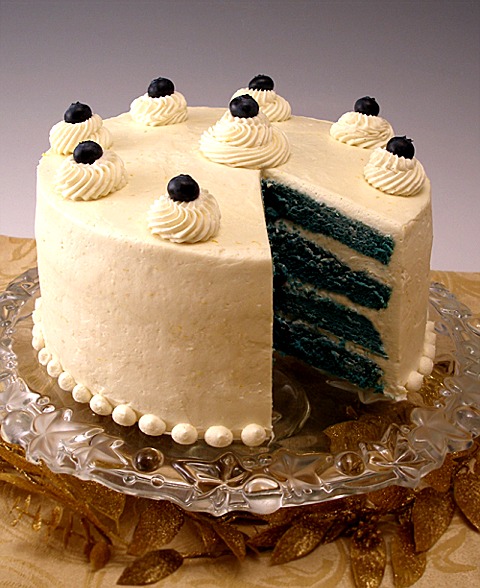
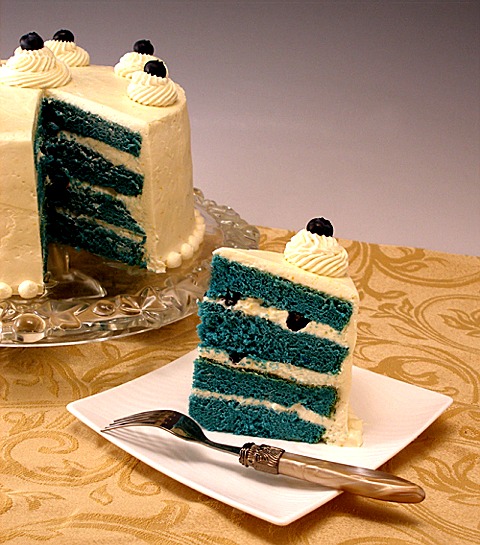
I developed the recipe to use the bare minimum of food coloring. I first saw a Blue Velvet Cake in LA’s Milk Shop Cafe, and decided that I wanted to invent a recipe. The only complaint about the LA’s Milk Shop cake was that it turned my mouth blue – and, I could only guess that it came from an excessive amount of blue food coloring being used in their recipe. I know that vibrant colors are difficult to get in a finished baked good, especially blue, because it tends to turn grey or green when baked; to get a true blue color, a lot of blue food dye has to be used, which was not what I wanted.
I wanted to invent a Blue Velvet Cake dying it blue the natural way. This isn’t a red velvet cake turned blue. I created a way to take a chiffon cake recipe, apply a natural way to tint it so the blue color would remain vibrant, especially after baking, and not turn someone’s mouth blue. We did, however, use 1/4 teaspoon food coloring to help enhance its color, but that is totally optional. The best outcome was a towering 3 layers of blueberry cake with White Chocolate Cream Cheese Frosting, and fresh blueberries, that WON’T turn your mouth blue.
CAKE RECIPE HELP
KELLY SAYS: “I brought this cake to a friend’s new year’s dinner celebration last night.
Let me tell you all about this cake!
The cake is very light and fluffy, as it should be.
The frosting is delicious. It tastes like lemony cheesecake, and it is not too sweet. It is a very creamy frosting, with none of the grittiness that can happen with powdered sugar buttercream frosting.
The cake doesn’t really taste overtly blueberry-ish, until you bite into one of the blueberries in the filling…SO yum!
The blueberries between the layers taste fabulous with the cake and frosting.
The cake is towering! It is a HUGE cake…4 luscious layers. Make the slices small, because it is uber rich!”
I got the idea of using blueberry juice as a natural dye for baking from my childhood. I remember as a child, we used the small Maine blueberries as a filling when we baked homemade Kolache pastries, and got blue all over our hands and mouths as a result. So, a light bulb went off in my head. Why not use concentrated blueberry juice, instead of water in the chiffon cake recipe to tint the cake blue? That way, I would only need a small amount of added food dye to help bring out the color. Since blueberry concentrate was hard to find at the grocery store, I found that boiling 100% blueberry juice and evaporating the water in it, concentrating it! I made a Cherry Pink version of this cake using 100% cherry juice, boiling it into a concentrate the same way. Have fun tinting this cake recipe in different and fun colors this way with less food dye and added antioxidants using fruit juices!
What you need for this tutorial:
1 recipe Blue Velvet Chiffon Layer Cake, Step I
1 recipe White Chocolate Cream Cheese Filling & Frosting, Step II
STEP I: MAKE THE BLUE “VELVET” CHIFFON LAYER CAKE
BLUE VELVET CHIFFON LAYER CAKE
INGREDIENTS
3/4 cup reduced 100% Blueberry juice*, cold, made from 2 cups 100% Blueberry juice concentrate (not juice cocktail), all-natural pasteurized, without sugar
12 large eggs; separated (You’ll need 12 egg yolks and 12 egg whites for the recipe)
1 3/4 cups bleached cake flour (not self-rising); spoon into dry measuring cup and level to top; DO NOT use a cake flour substitute.
2 teaspoons baking powder
1/4 teaspoon baking soda
1/2 teaspoons salt
1 1/4 cups sugar or superfine sugar; divided into 1/2 cup and 3/4 cups
1/2 cup vegetable oil
2 teaspoons vanilla extract
1/4 teaspoon or 8 drops Royal Blue gel food coloring, Americolor
1 to 2 drops Violet gel food coloring, Americolor
1/2 teaspoon cream of tartar
Equipment:
Make two ALUMINUM COOLING PANS: from 9 1/4 diameter x 2 3/4-inch height aluminum disposable casserole pan. See below.
NOTES
#Food Coloring:There are also natural food dyes from http://www.naturesflavors.com/ They do not dye as vibrantly
*How to reduce 2 cups 100% Blueberry juice from concentrate to 3/4 cup for use in this recipe:
We used: 100% Blueberry juice from concentrate (not juice cocktail), all-natural pasteurized, without sugar
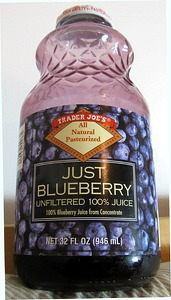
SARAH SAYS: If you cannot find blueberry juice, use 3/4 cup water less 2 tablespoons in the recipe, in its place. Then, in Step #2D, add in a total of 2 tablespoons Royal Blue gel food coloring, Americolor, plus 1/4 teaspoon Violet gel food coloring, Americolor.
1. In a heavy-bottomed saucepan, under medium-high to high heat, boil 2 cups 100% Blueberry juice, for about 17 to 20 minutes, and reduce it to 3/4 cup for the recipe.
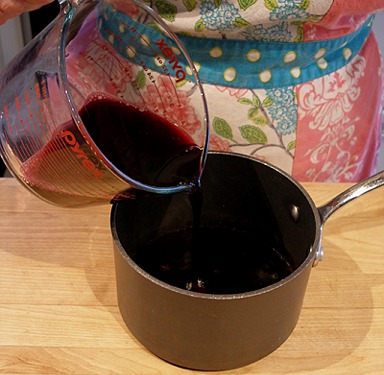
2. Chill in an ice water bath to use cold; do not add ice to the blueberry concentrate. Or, refrigerate until needed in the recipe.
INSTRUCTIONS
1. Preheat the oven and prepare the baking pans:
A. Position the oven rack in the middle of the oven and preheat the oven to 350 degrees F.
SARAH SAYS: In my oven, the center rack is the third rung up. When you have an even number of racks, and have to choose as to whether the third or fourth rack up is the middle, as I do in my oven, when in doubt, go to the lower rack of the two.
B. Prepare two 9 x 2-inch baking pans. Set aside:
SARAH SAYS: DO NOT use a non stick pan. The cake needs to be inverted to cool. You don’t want the cake to fall out of the pan which it will with a non-stick one. For light-colored cake sides, use a light, heavy aluminum pan, not a dark-colored one.
1. Place one pan on top of a piece of parchment paper and trace around it with a pencil. The lead is nontoxic.
Cut out the round of parchment paper following the pencil marks as a guide.
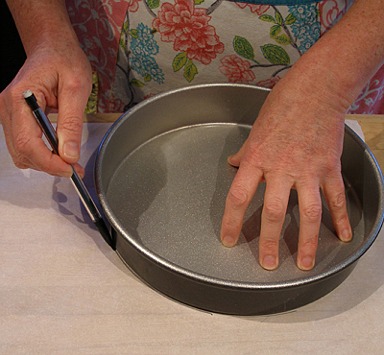
2. Place the parchment paper round on top of the ungreased pan bottom.
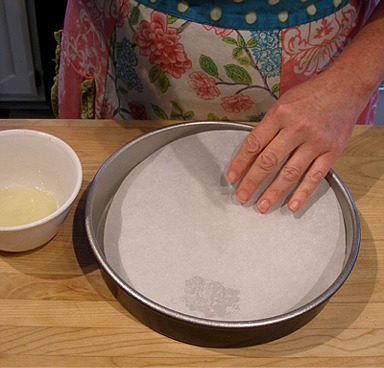
3. Grease the bottom of the parchment paper round with melted butter or vegetable oil with a pastry brush. Do NOT grease the side of the pan.
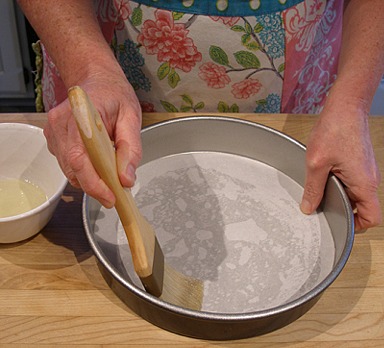
4. Repeat with the second pan.
2. Make the cake batter:
A. Combine the dry ingredients:
1. In large mixing bowl, preferably with a wide rim, sift together the flour, baking powder, baking soda and salt. Repeat two more times. If you don’t have a sifter, use a fine mesh strainer.
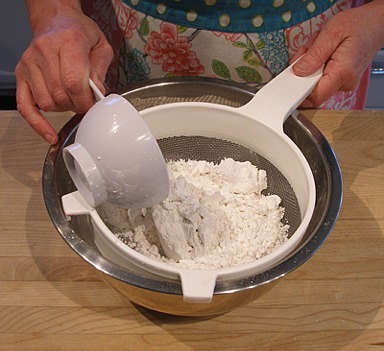
2. Add in 1/2 cup sugar. Whisk together to blend.
3. Make a well in the center of the flour mixture.
B. Prepare the batter mixture:
SARAH SAYS: In the well of the flour mixture, add the following, in order WITHOUT mixing:
1. Add the oil
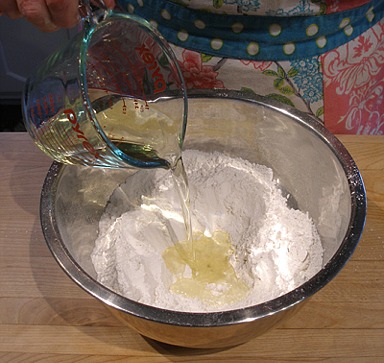
2. Add the 12 egg yolks;
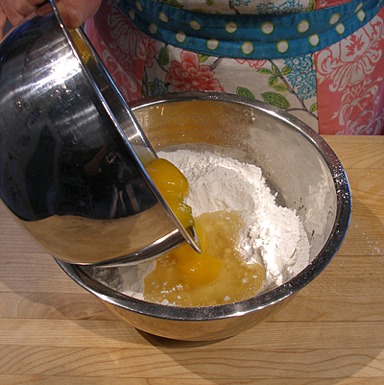
3. And, finally, the cold 3/4 cup reduced blueberry juice and vanilla.
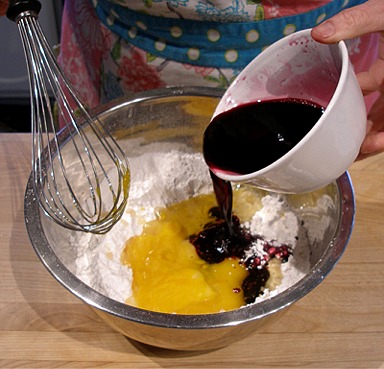
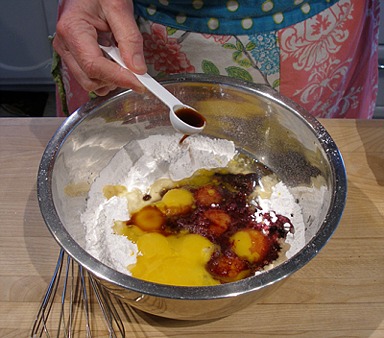
SARAH SAYS: The reason for layering the ingredients in a certain order before mixing helps form the batter properly. I have found, through my extensive testing of a wide variety of Chiffon Cake Recipes (and I mean extensive), that some failed while others didn’t. I set out to find out why. I found that one of the biggest causes of failed Chiffon Cakes, besides the improper beating of egg whites and not properly folding the recipe together, is ALSO the improper formation of the cake batter (not written about anywhere — yes, you heard it here first!) Many recipes have you simply dump all of the batter’s ingredients into the bowl without regard to order or mixing method, which you’ll observe if you look through most cookbooks, leading to many failed recipes and unhappy bakers.
C. Mix and strain the batter ingredients:
1. With a wire whisk, mix together the batter ingredients until smooth.
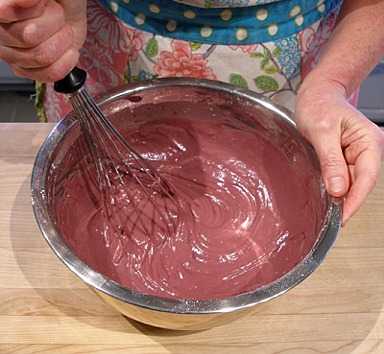
2. Strain the batter mixture through a fine mesh strainer by pushing the mixture through with the help of a rubber spatula to a large bowl below. Discard any flour lumps that are left in the strainer.
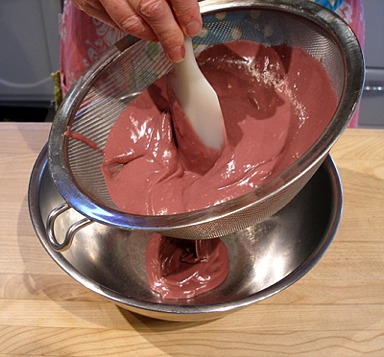
It is critical that the resulting batter mixture is smooth and without lumps because when the cake bakes, the flour lumps will stay that way.
HELP! I had to throw away a lot of flour lumps. I’m worried that there isn’t enough flour left for the recipe. What should I do?
SARAH SAYS: ONLY if there is a tablespoon or MORE of flour lumps left in the strainer, sift a tablespoon of flour on top of the mixture and stir. But, be careful you don’t get into the vicious cycle of adding flour and then straining the batter mixture.
D. Add the Blue and Violet gel food coloring to the strained batter mixture. Cover the batter with plastic wrap and set aside.
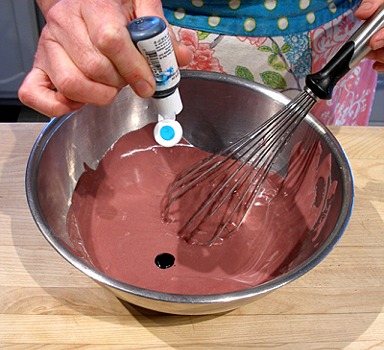
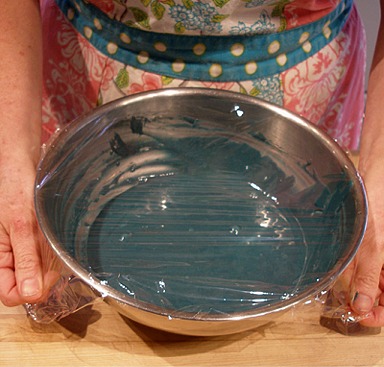
3. Beat the 12 egg whites until they are stiff and glossy: Use a stand mixer when you have a large amount of whites to beat, such as this recipe.
A. Place egg whites in a clean, dry grease-free mixer bowl of a stand mixer. Make sure there are no egg shells in the mixture.
SARAH SAYS: You can whip the egg whites if they are still cold. The real issue with egg whites is their freshness, not temperature, so you can beat whites right from the refrigerator, althought they may require slightly more beating time. Newer fresh eggs have thicker whites and will reach more volume and have greater stability when beaten than older eggs.
B. With a stand mixer fitted with a whisk attachment, beat egg whites on low until foamy.
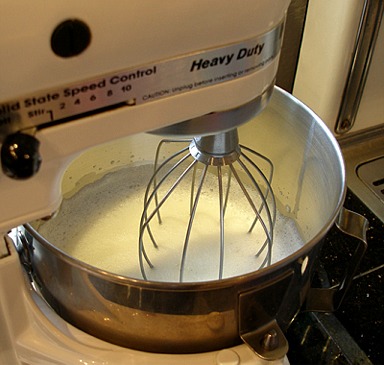
SARAH SAYS: As air is beaten into the egg whites, they will start to lighten in color. This beginning step is one of the most overlooked and important steps. If egg whites are beaten too quickly at the beginning, the structure of the foam will not be as strong, and later the egg whites will not beat as high as they should.
Keep mixing the egg whites on low speed. The egg white foam will increase in volume and become white and have large bubbles.
C. With the mixer running, immediately add the cream of tartar at the side of the bowl.
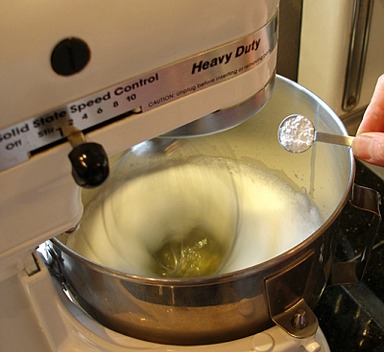
SARAH SAYS: Adding a small amount of acid, such as cream of tartar, lemon juice or vinegar, stabilizes egg whites and allows them to reach their full volume and stiffness. It does this by making the egg coagulate faster.
D. The bubbles in the egg white foam will become smaller and more even in size. When it reaches this stage, increase the mixer speed to medium-high.
E. Then, add 3/4 cup sugar slowly in a steady stream at the side of the bowl. After the sugar has been added, increase the mixer speed to high.
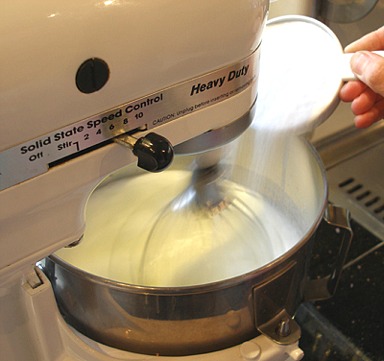
Always add sugar in a stream, slowly at the side of the bowl while the whites are being whipped; do not dump it in the center — you don’t want to risk deflating the whites.
SARAH SAYS: I stopped the mixer so you could see how the egg white foam is beginning to become glossy. This is called the soft peak stage. It is reached when the peaks of the whites droop slightly, when the beater is turned off and lifted.
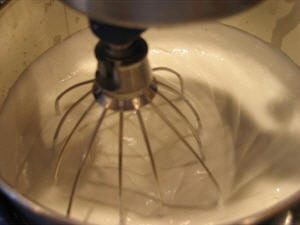
But, this recipe calls for beating the whites to the stiff peak stage…so keep beating with the mixer on high.
F. Beat until the egg whites are white, fluffy, very stiff and still very glossy.
For this recipe, the whites should be stiffer than most. They will form lumps as the mixer beats. STOP beating when they start to form lumps around the beater as shown in the photo.
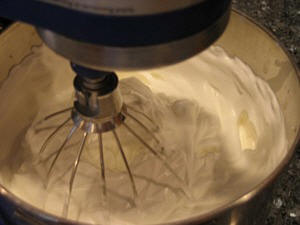
To test if properly beaten to the stiffly beaten stage, take the mixer bowl from the mixer or lift the beaters. You can gently cut a table or icing knife through the middle of the beaten egg whites; it creates a narrow grove with stiff walls. If not, continue beating for a few seconds more and perform the test, again.
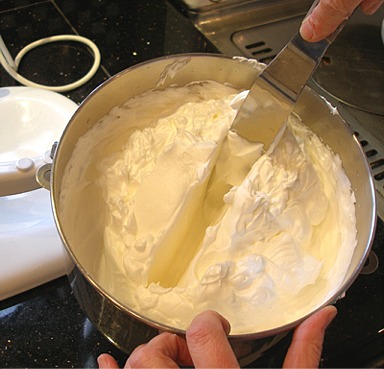
SARAH SAYS: Another test to perform to see if your egg whites are stiffly beaten are to stop the beaters and then lift them — straight and stiff peaks should form.
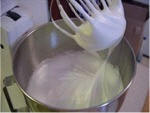
HELP! I’ve overbeaten my egg white mixture. Do I have to throw them out and start again! I just wasted twelve eggs and all of the time separating them…I’m heart broken!
SARAH SAYS: Do not overbeat the egg whites; if they are beaten too stiff, they lose their gloss and look curdled. Unfortunately, there is no more stretch left for them to rise when baked — some or will pop during the whipping stage and will collapse. To fix, try whisking in another egg white with a wire whisk — DO NOT use the electric mixer. If you can’t fix them, unfortunately, you have to start over again with fresh egg whites…
4. Fold the egg whites and the batter mixture until thoroughly blended
SARAH SAYS: When you fold the batter and beaten egg whites together, they must be thoroughly blended; you need to make sure all of the air bubbles are encased in batter, otherwise the cake won’t rise properly. The batter will set around the air bubbles when the cake bakes in the oven, allowing it to puff properly. In essence, the folding action breaks up the air bubbles into smaller ones and encases each one in batter, like putting mortar in between small tiles to hold them in place. If the “mortar” isn’t evenly distributed between the “tiles” and you have some large and small tiles, you’ll get an uneven looking “floor” or cake crumb. Some “tiles” or air bubbles will be “loose” or escape from the cake batter and cause large holes in the cake. You’ll see a pattern of “tiles” or egg whites grouped together separately from a layer or “mortar” or batter grouped together. Your “floor” or cake will be uneven and won’t rise as high in the oven. With foam cakes, it’s normal to see some uneven air holes in the cake’s crumb (inside), but not large pockets of air holes, egg whites and/or batter. That means that the folding action was not done enough or was done too much where you managed to pop a lot of air bubbles. Folding takes a lot of practice to get right.
A. To start, use the batter mixture that was previously set aside. Stir it a few times to mix it thoroughly before using.
With a large rubber spatula, gently scrape 1/3 of the beaten egg whites on top of the mixture. Never add the batter to the whipped whites or the heavier mixture on top of the lighter, beaten they’ll deflate.
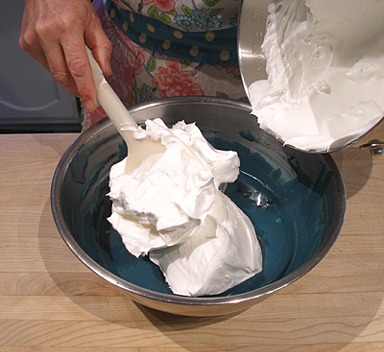
B. With the rubber spatula, in a large circular sweeping motion as if you are turning a crank, lightly combine the egg whites and batter. Do this one or two times. Be sure to scrape the bottom of the bowl.
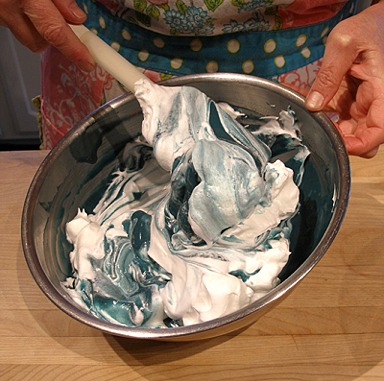
C. Starting on the top, cut down from the center of the mixture to the bottom of the bowl, then draw the scraper quickly toward you against the edge of it, and up to the left and out. You are thus bringing a bit of the mixture at the bottom of the pan up over the egg whites or “folding it over”. Then turn the bowl a quarter turn and repeat until you only see slight streaks of white. You will need to scrape the sides of the bowl a few times to keep the mixture from climbing up the sides.
D. Repeat with the last two additions.
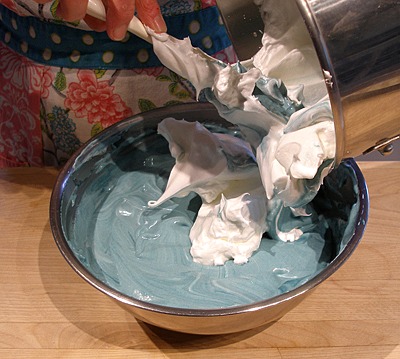
E. Fold the last of the egg whites and the batter mixture until almost completely combined. You’ll still see a few streaks of eggs whites. The batter and egg mixture will become smoother.
F. Continue the folding movement while slowly rotating the bowl, and cutting down, towards you, and out to the left, until the egg whites have been folded into the body of the batter. You shouldn’t see any streaks of batter and eggs whites in the mixture. The mixture should be smooth. Sometimes you’ll see with a few small lumps visible; it just means that you slightly overwhipped the egg whites. Do not continue to fold the mixture because you’ll start to remove the air from the batter.
5. Bake the cake layers:
A. Immediately divide the batter evenly into the prepared pans. The batter will fill close to the tops of each pan. (Note how light and fluffy the batter is.)
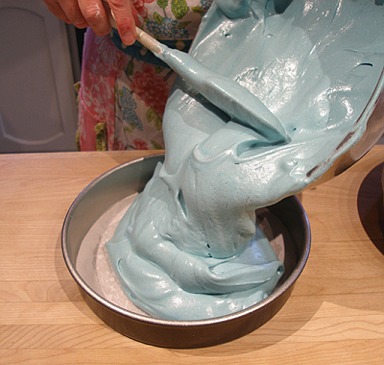
B. Run a table knife or thin icing spatula through the batters in an “s” formation so large air pockets will break-up into smaller ones. It will also break up any egg white clumps. The rest will dissolve into the batter. DO NOT bang the pans on the countertop because this eliminates air from the batter, which you don’t want to do!
C. Gently smooth the tops with a rubber spatula. Clean off the extra batter on the sides of the pans with a wet paper towel.
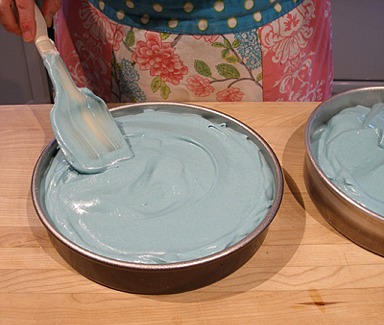
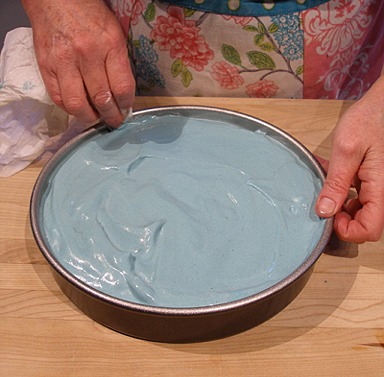
D. Immediately place the filled pans in the middle shelf in a well-preheated 350 degree F oven.
E. Bake for 30 to 40 minutes or until the cakes are a deep golden brown on top and spring back when touched lightly with the open palm of your hand – avoid poking them too much because you’ll create dents.
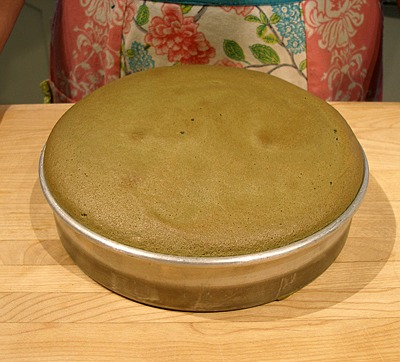
Insert a long wooden skewer in their centers and it should come out with no batter attached or perhaps a tiny moist crumb or two. The top may crack during baking – it’s ok. To further test for doneness, also poke the cake with a wooden skewer in its cracks because that’s where the cake can still be underdone! Do NOT overbake or the cake will start to shrink from the sides of the pan and taste eggy.
Do NOT overbake or the cake will start to shrink from the sides of the pan and taste eggy. It will also fall from its pan when inverted, in the next step.
6. Thoroughly cool the cake layers in their pans while inverted:
A. Remove the cakes from the oven and immediately turn them in their pans over and hang each layer upside-down, in their Aluminum Cooling Pans to cool thoroughly, taking up to 1 1/2 hours to complete. The cakes will rise higher in the oven and fall back slightly when you remove them from the oven. Once you invert the cakes to cool, the cake will stretch and set with a domed top, although not as high as it had been in the oven. The cake tops will crack somewhat; it’s ok if they do.
SARAH SAYS: If the cake starts to fall out of its pan while inverted or cracks too much while doing so, do not invert. Instead, simply cool the cake layer upright it in its pan on a wire cake rack.
HOW TO PREPARE THE ALUMINUM COOLING PANS:
Proper cooling is just as important as baking. The cakes are inverted in their pans to cool which prevents their structure from shrinking or falling, giving the open texture that’s characteristic of chiffons. If placed to cool on a rack, it would deflate much of that hard-earned volume. I invented a way to cool chiffon cakes baked in a cake pan because they wasn’t a good way to complete this task in order to preserve the unique texture of this cake; if not inverted, the cake’s airy crumb collapses as it cools, destroying all the careful mixing you have done to ensure a light and airy cake.
MY INVENTION: SARAH SAYS: I found that a disposable aluminum casserole pan, cut with air holes so air can circulate around the hot cake to enhance cooling, makes a perfect way support my cake layer as it cools. (Make sure you don’t use anything that is plastic otherwise the hot pan will melt it.)
A 9 1/4 diameter x 2 3/4-inch height aluminum disposable casserole pan (purchased from the grocery store) works perfectly with a 9-inch cake pan. You will need two for this recipe!
The cake pan’s rim fits exactly and securly on the rim of the disposable pan, and when the cake stretches while it cools, and the cake doesn’t touch the sides or bottom of the aluminum pan which would mar the cake if it did. The best part is that the pan is inexpensive and can be purchased from the grocery store. You only need one for this recipe!
To make: Carefully cut vertical slits or squares with scissors or a small, sharp knife near the rim of the pan in the side to allow for air circulation. Repeat with the second aluminum pan.
Then, place the disposable pan on top of the cake pan. Be careful because the cut slits become sharp.
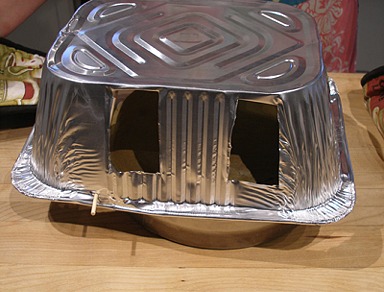
Then, flip the two over together with pot holders because the cake pan is really hot, so the cake pan is on the top. The cake will hang up-side-down to cool.
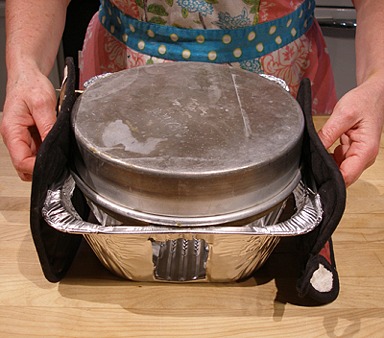
Repeat with the second baked cake layer.
SARAH SAYS: Here’s the difference in a cake cooled upside-down and one cooled right-side up.
The cake cooled in its pan on a wire cake rack has a wrinkled top and a denser inside cake crumb. The cake collapsed while cooling. The cake will be drier and have a less vibrant taste as a result.
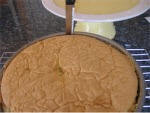
VERSUS
The cake that cooled while upside-down has a less dense cake crumb and a slightly domed top. It’s really important that you cool a foam-type cake upside-down so the cake’s structure can set stretched-out, giving a lighter, airy texture and more vibrant flavor.
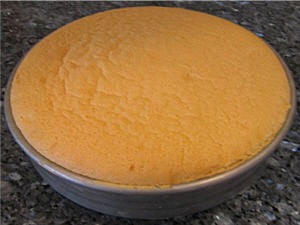
NOTE: KELLY SAYS: I could not find the pans specified, so I bought aluminum roasting pans, cut the steam holes in the sides and used a wooden skewer to hold up one side of the pan. It worked great!
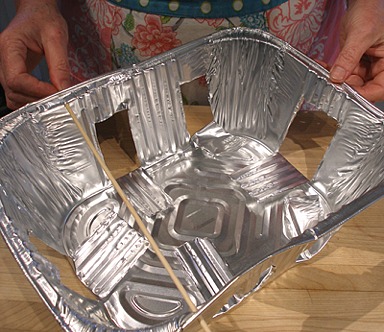
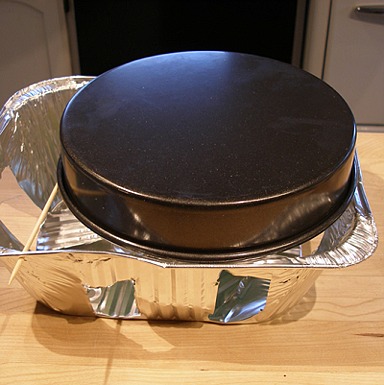
STEP II: MAKE THE WHITE CHOCOLATE CREAM CHEESE FILLING & FROSTING
WHITE CHOCOLATE CREAM CHEESE FILLING & FROSTING / Recipe alone – one layer
Make sure you use a high quality white chocolate and you won’t be disappointed.
INGREDIENTS
1 cup (8 ounces) heavy whipping cream
1 pound (16 ounces) white chocolate, chopped; use an excellent quality
4, 8 ounce (32 ounces total) packages cream cheese, softened; I prefer Philadelphia Brand
3 teaspoons lemon zest
2 teaspoons vanilla
Filling: 1 pint whole blueberries, saving 12 prettiest ones for the top
SARAH SAYS: White chocolate typically lists cocoa butter as the first ingredient; the higher the ratio of cocoa butter in the product, the finer the confection. If cocoa butter is not listed as an ingredient, the product is a white compound or confectioner’s coating. The term “white chocolate” is a misnomer, however, as chocolate refers to the brown chocolate liquer found when processing the cocoa beans. White chocolate should be handled carefully – it should not be over heated. In this recipe, the cream should be just barely warm enough to gently melt the chocolate. If the chocolate gets too warm, it may “seize” and clump up or refuse to melt.
KELLY SAYS: I used lemon zest from the Meyer Lemons which grow in my backyard. The peels have an orange cast to them.
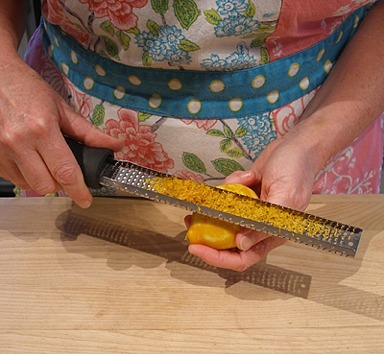
INSTRUCTIONS
1. Place the cream in a large microwave-proof bowl. Gently heat in the microwave until 50% power, for 2 minutes at a time. Stir between each session.
You do not want the cream to be boiling hot.
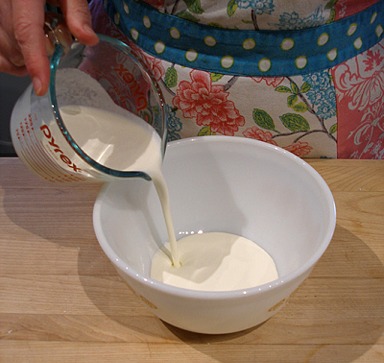
2. Add white chocolate to cream and stir until melted. Cool to room temperature.
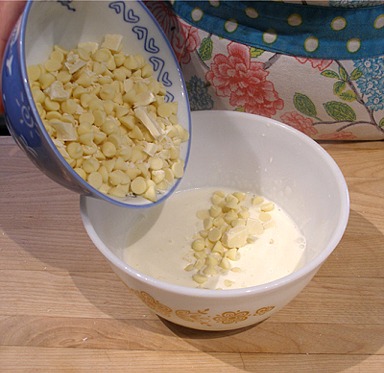
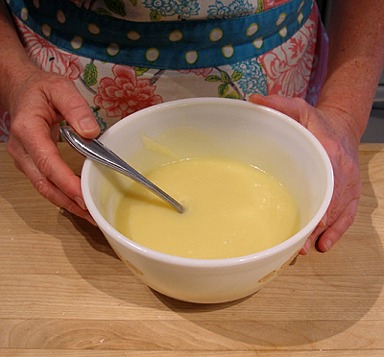
3. With the electric mixer fitted with a whisk attachment, beat cream cheese and lemon zest together.
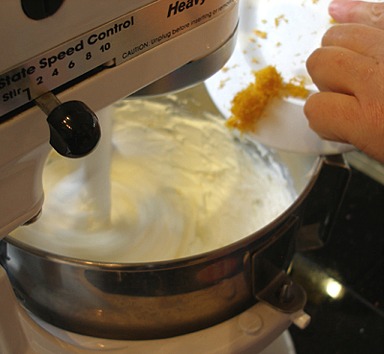
4. Add white chocolate and cream mixture; whip until smooth.
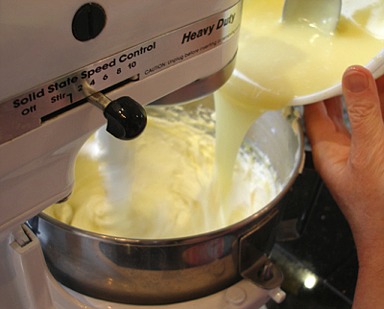
SARAH SAYS: Do NOT overbeat. If the frosting is too thick, add in drops of milk or cream to correct. If too thin, add in more cold CREAM CHEESE.
If frosting is too soft, try to refrigerate until it has stiffened.
STORAGE
Cream cheese frosting is perishable and must remain refrigerated. The frosting will keep for a few days in an airtight container.
STEP III: UNMOLD, ASSEMBLE AND SERVE THE CAKE
1. Remove the White Chocolate Cream Cheese Filling & Frosting from the refrigerator. Let sit until it warms to the cool side of room temperature and stir before using.
2. When the cakes are completely cooled, remove the layers from their pans:
A. Gently loosen the sides of cake with a thin-bladed, flexible knife, moving the knife firmly in one direction; do not use a sawing motion.

The other layer cracked on top while cooling up-side-down; it ok if it does.
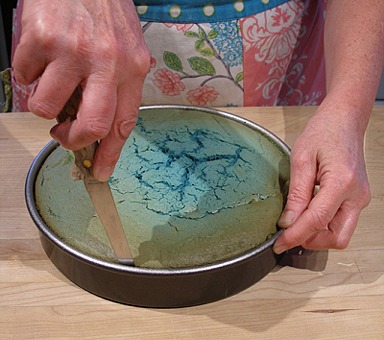
B. Invert each onto a piece of plastic wrap.
C. Remove the parchment paper on each of the cake layer’s bottom.
3. Divide each cake layer:
A. With a sharp serrated knife, using small, quick sawing motions, divide each cake layer into two horizontal layers. You will have 4 layers.
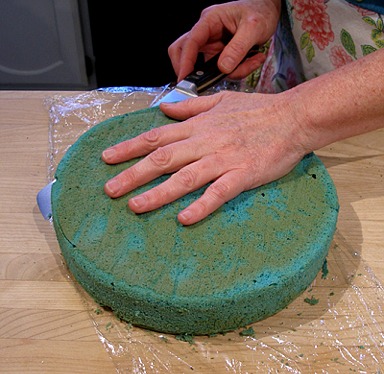
4. Fill each cake layer and crumb coat with the White Chocolate Cream Cheese Filling & Frosting:
SARAH SAYS: Make sure the filling and frosting does not get too warm. Refrigerate, if necessary.
A. Place strips of waxed paper on the edges of your cake plate, to protect it while you frost the cake.
B. Place one layer, bottom side down. Place 1/2 cup White Chocolate Cream Cheese Filling & Frosting in the center of the bottom layer.
I use a large icing spatula to spread mine.
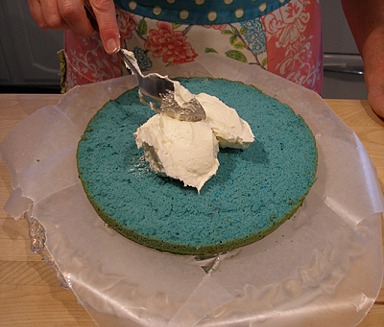
C. Press 15 – 20 blueberries into the frosting.
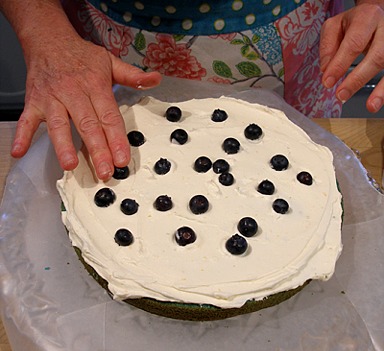
D. Place the second layer, cut side down.
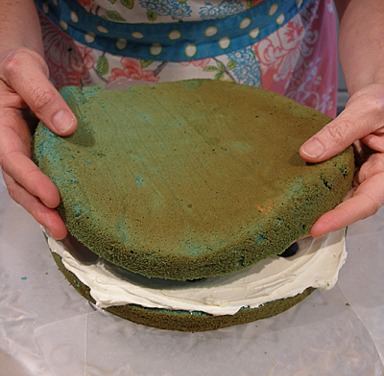
E. Fill the second and third layers with 1/2 cup White Chocolate Cream Cheese Filling & Frosting. Press 15 – 20 blueberries into the frosting.
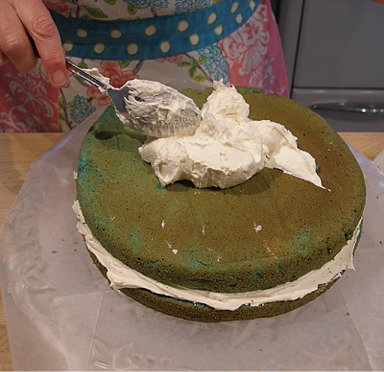
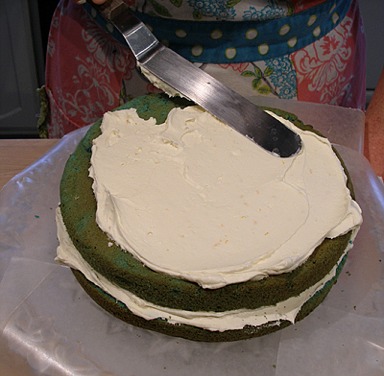
F. Place the third layer, bottom side down, and continue to crumb coat the layer on the outside after I stack it.
KELLY SAYS: I like to start crumb coating the layers on the outside as I build them up. I use the excess frosting from the filling to do so.
This way, the layers stay more securely stacked on top of one another. You will see what I mean in Step F, next.
G. Place the final layer on top, cut side down.
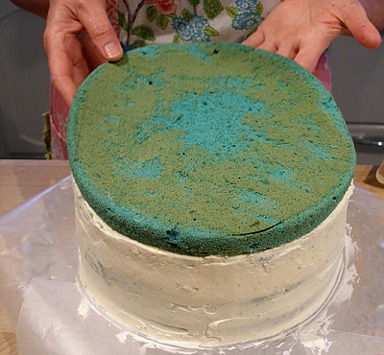
H. This is the last of the crumb coat.
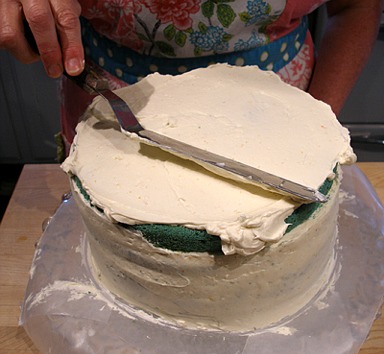
5. After chilling the crumb-coated cake for 20 minutes, add the final coat of frosting and smooth it.
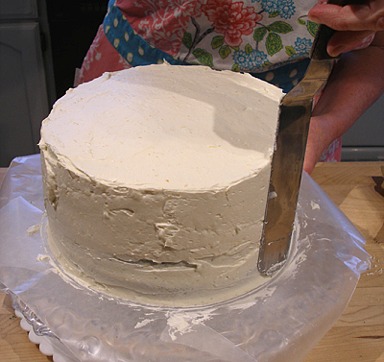
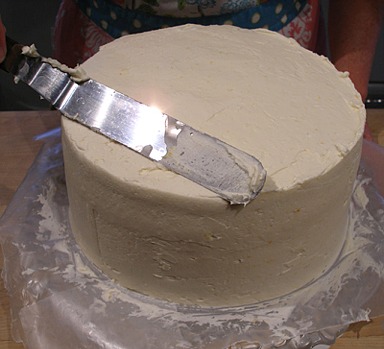
6. Optionally decorate the cake:
KELLY CA SAYS: I decorated the frosted cake to look like the one they serve at LA’s The Milk Shop!
I used a large open star pastry tip to make rosettes on top of the cake, crowning each one with a plump blueberry. I used a Kaiser 15mm 50-3 tip.
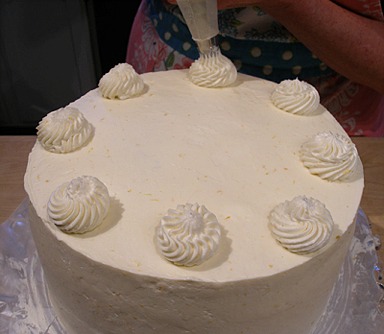
Carefully remove the waxed paper from the cake plate, then, using a medium plain tip, I piped small “pearls” on the bottom edge of the cake.
I used a Wilton #10 tip.
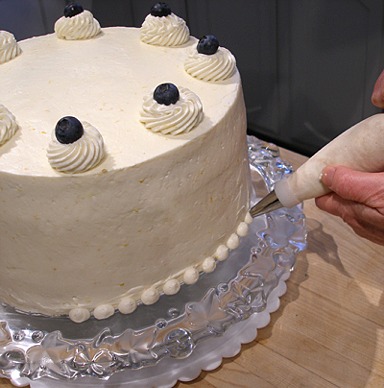
7. Refrigerate cake for about 30 minutes before serving.
SERVE
Serve cake by cutting with a sharp serrated knife in a sawing motion or with an electric knife. If you use another type of knife or press straight down, you’ll squish the cake.
STORAGE
Refrigerate cake if filled or frosted with perishable items, such as the White Chocolate Cream Cheese Frosting, where it will keep for a few days.
Unfrosted chiffon cakes can be frozen for two months or so, but suffer somewhat in texture when thawed. It’s best to freeze cake before unmolding from their pans. Afterwards, place layers in airtight containers.




